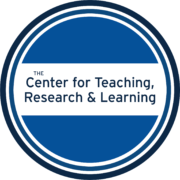Self-Assessment of Teaching Statement
Also known as: teaching philosophy, philosophy of teaching, teaching interest statement
To help guide your self-reflection through writing a teaching statement, we have provided several guiding questions. These questions are meant to prompt you to reflect on your teaching practices and the “why’s” behind them, as well as to point out what information can be included in a teaching statement. You can find the guiding questions on CTRL’s “Writing a Teaching Statement” Page.
The questions below are meant to help you self- assess the strength of your teaching statement, and can be answered with a yes or no. Note that while you do not need to answer “yes” to every question, it can be helpful to reflect on why you chose or didn’t chose to include particular information in your statement, and you may consider adding additional information based on these self-reflection questions. Additionally, your teaching statement should include some aspects of each category, as well as a clear commitment to diversity, equity, inclusion, and justice (DEIJ).
Beliefs about Teaching—Does the statement…
- clearly articulate your beliefs about how teaching & learning work?
- explain how your beliefs are informed by your research and/or discipline?
- connect these beliefs to your personal experiences (both as a learner and as an instructor)?
- explain why you hold these beliefs?
- articulate how your beliefs account for the varying identities and experiences of students?
Teaching Strategies—Does the statement…
- explain why you use particular teaching strategies?
- articulate how your teaching methods are informed by your beliefs about teaching & learning?
- offer detailed examples of the strategies you use and your reasoning behind using them?
- explain why your teaching methods are appropriate for your discipline?
- describe how these methods serve diverse populations of students?
Impact of Teaching Strategies—Does the statement…
- use evidence to demonstrate the effect your teaching strategies have on students (e.g., student feedback, your own observations about student learning, and educational research)?
- share ways in which you gather feedback on your teaching from students and/or peers?
- explain how you reflect on the effectiveness of your teaching strategies?
- employ different types of evidence (quantitative, qualitative, anecdotal, etc.) to show the effectiveness of your selected teaching strategies?
- describe how the strategies you use are effective for students across a variety of experiences and identities?
Professional Growth and Development—Does the statement…
- explain how you have adjusted your teaching over time, based on what you have learned from students and their feedback, your own educational research, and/or pedagogical training?
- offer past examples of how you have incorporated feedback to improve your teaching?
- describe a clear plan to improve as an instructor in the future?
- state what you are looking forward to about teaching in the future, or a teaching goal that you would like to reach?
- explain how your future teaching-related goals fit into your broader scholarly and professional goals?
Writing Style—Your statement should demonstrate competency and accountability for your teaching by using a first-person, present tense voice.
Formatting— Instructions on formatting can be found by contacting your department chair or colleagues that recently went through the tenure promotion process.

